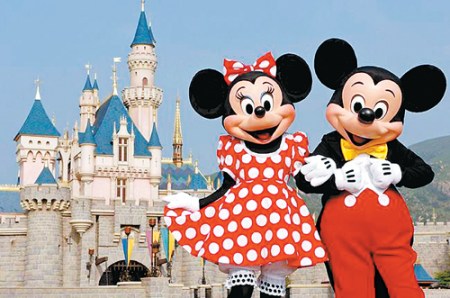|
|
双语阅读:本土动画遭遇强劲对手迪斯尼(图) 中国本土动画会让位于迪斯尼吗?
After more than a decade of haggling, Shanghai has finally secured a Disneyland。 But amid all the excitement and anticipation, almost unnoticed, is the historical irony of a Disneyland in Shanghai。 Almost 70 years after producing Asia’s first cartoon film, the city now has to borrow an US animation icon – at staggering cost, reportedly 25 billion yuan ($3.66 billion) to entertain its children and boost its tourist appeal。 And this is happening in a country with a vibrant tradition of cartoons and comics, and a government that favours its indigenous animators with a fervour rarely seen elsewhere。 A recent surge in control, an artificial industry boom driven by hunger for government subsidies and rampant piracy have undone most of the mainland animation industry’s heritage advantages and preferential government policies。 The sector flourishes in terms of quantity rather than quality and fails to represent China’s cultural identity or extend its soft power, something mainland cultural authorities expected it to do。 Piracy also took its toll, but a more convenient scapegoat was imports of foreign anime, which flooded the market in the 1980s and 1990s amid a burgeoning mainland television industry。 In 2005, a China Animation Association survey found that domestic production houses accounted for only about 10 percent of market share in a business worth 18 billion yuan a year. The Monkey King and folklore heroes conceded their status as Chinese childhood idols to American Transformers and Japanese Godzilla fighters。 In the name of staving off the invasion, a series of targeted restrictions and incentives were rolled out. Domestic animation companies were given tax breaks and, in some cases, direct subsidies。 Government-sanctioned "animation and cartoon industry parks" began springing up around the country. There are now more than 40. With such favouritism, the volume of home-grown animation produced each year soared from around 20,000 minutes in 2004 to more than 100,000 minutes last year. But Ouyang Jian, a deputy culture minister, estimated last year that up to 90 percent of domestic animation firms are deep in the red。 The sequel to Pleasant Goat and Big Big Wolf, produced by Shanghai Media Group (SMG), hit mainland screens late last month。 But the success of the first movie owed much to a namesake TV cartoon series, which benefited directly from the favourable prime-time airing granted to domestic animation. Claims have also surfaced that government-backed SMG collaborated with State-owned chain cinema operators to prolong the movie’s screening slot and help boost its balance sheet。 Yet even in that environment, it still reaped just half the mainland takings of DreamWorks’ Kung Fu Panda (140 million yuan)。 经过10年的讨价还价,上海终于把迪斯尼搞定。在兴奋和期待中,几乎未被察觉的是其中的历史性讽刺。 在出品了亚洲首部动画电影近70年后,这座城市如今不得不借助美国动画的符号、以难以置信的代价,据传250亿元人民币,来取悦孩子们并增强自己的旅游吸引力。而这发生在一个具有丰富的漫画和连环画传统的国度里,其政府对本土动画的偏爱甚于其他国家。 最近一轮的审查、被渴望政府补贴所驱动的虚假产业繁荣及猖獗的盗版,破坏了大陆动画产业的传统优势及政府的优惠政策。这个行业的繁荣是在量而非质,无法代表中国的文化个性或延伸其软实力。 盗版造成损失,但更适宜的替罪羊是外国动漫的进口。上世纪八九十年代,随着大陆电视产业的迅速发展而在市场上大行其道。2005年一项调查显示,在年商业价值180亿元人民币的市场份额中,本土制作机构只占10%。曾是中国人童年时偶像的美猴王和民间英雄让位给美国的变形金刚和日本的哥斯拉战士。 以阻挡入侵的名义,一系列定向的限制和鼓励措施出台。国内动画公司获得税费减免,有时是直接补贴。政府批准的动漫产业园开始在全国涌现。目前有40 多座。 借助这样的优势,国产动画的年制作量由2004年的2万分钟飙升至去年的10万分钟。但文化部副部长欧阳坚去年估计,90%的国内动画公司都负债累累。 由上海文广新闻传媒集团(SMG)制作的《喜羊羊与灰太狼》续篇上月在大陆上映。该电影首篇的成功大部分归功于同名电视卡通片。该片直接得益于国产动画的黄金时段播出许可,还有披露称,政府支持的SMG与国营电影院连锁合作,延长电影的上映档期,以平衡资产负债。即使在这种环境下,它依然只获得了梦工厂的《功夫熊猫》在大陆斩获的一半票房(1.4亿元)。 网友评论
企业服务 |
||||||||||||||||







